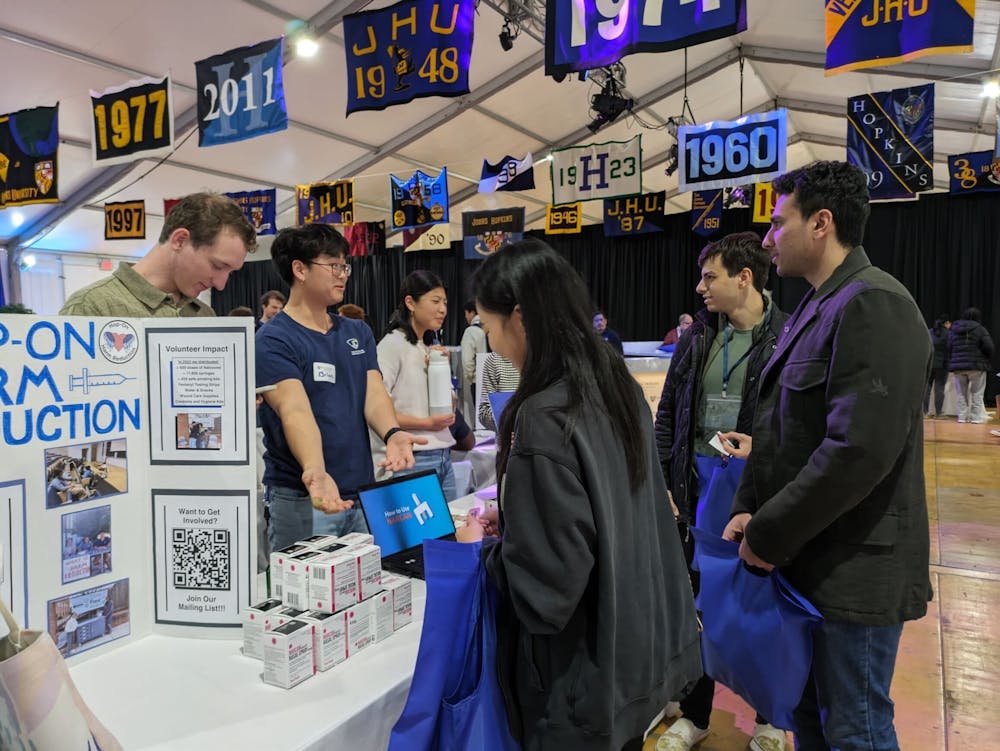Hop On Harm Reduction (HHR) is a student-run nonprofit organization at Hopkins that seeks to bring awareness of drug use and harm reduction to the Homewood student body. The organization also assists individuals who use drugs in the wider Baltimore community to foster safe and responsible substance use behaviors.
In an interview with The News-Letter, seniors Shirley Xie and Garrett Gregory shared their experience as co-presidents of the organization, discussed HHR’s impact in the Baltimore community and addressed some common misconceptions about the group’s work.
Emphasizing the importance of HHR’s mission in Baltimore and beyond, Gregory highlighted the current “War on Drugs” in the U.S. and its in effectiveness in reducing drug abuse.
“The U.S. saw a rise in drug use and overdose rates, and the reaction was to criminalize the act of using drugs,” he said. “It was largely unsuccessful… Overdose rates today continue to skyrocket while incarceration rates have really risen.”
Instead of focusing on stopping people from using drugs, HHR puts its emphasis on providing individuals who use drugs with the tools and resources to do so in a safe manner. It also aims to empower them to have more self-care abilities in the long term.
Xie offered an analogy for the role the organization plays in confronting drug abuse.
“[HHR] is like a seatbelt,” she said. “Driving is an inherently risky behavior. It’s not so much that we are trying to get people to stop driving. We are trying to make this act safer.”
The organization hosts a variety of events. Within Hopkins, HHR provides opioid overdose and response training, distributes free Narcan and hosts a speaker series on building awareness of harm reduction. In the wider community of Baltimore, the organization gathers volunteers to distribute hygiene products and aid kits.
According to HHR’s 2023-2024 Annual Report, HHR distributed 729 boxes of Narcan, 13,080 long syringes, 317 smoke kits and more between fall 2023 and spring 2024, with volunteers making 1,025 interactions in the Baltimore community.
Both Gregory and Xie believe that the biggest challenge the organization faces is the common misunderstanding of the concept of harm reduction. One of the most common questions they receive is whether the club is enabling and encouraging substance use.
Xie answered the question by describing how being a “non-judgemental” space is a defining characteristic of the organization.
“People are going to use drugs anyway. It’s a deeply personal issue… We are just making the entire process safer,” she explained. “Our goal is to meet people where they are. We would never push treatment on anyone.”
Gregory also pointed out the social stigma associated with drug use and how this stigma prevents individuals who use drugs from acquiring basic healthcare.
“We are kind of taught to be afraid of people who are homeless and people who use drugs,” he said. “But they are people. They deserve to be treated with dignity and respect.”
Apart from distributing hygiene products and kits, raising awareness about drug use and harm reduction in the Hopkins community is a central part of HHR’s mission, especially educating students from outside Baltimore.
“Baltimore has the highest overdose rate in the nation,” Gregory said. “I wasn’t super aware before I came to Hopkins. Probably a lot of other Hopkins students are also not aware of the problem.”
Between 2017 and 2021, Baltimore City was responsible for 38.4% of all opioid-related deaths in Maryland. During this period, the number of opioid-related fatalities in the city rose by 45.95%. On average, Baltimore saw approximately 866 opioid-related deaths annually over these five years. The crisis disproportionately impacts underserved neighborhoods, compounding existing health disparities.
Gregory also described the feelings of two Baltimores that he experienced while participating in Harm Reduction.
“It really is two different Baltimores to experience [between] just being on Hopkins campus and actually seeing what different citizens in Baltimore go through, the challenges they face,” he added.
Gregory and Xie encouraged more Hopkins students to join HHR. They both shared stories of their personal growth in the organization. Gregory discussed his interest in social justice and how HHR has deepened his understanding of his own place in the wider community.
“I’ve definitely learned a lot about social justice in general and learning more about my own biases and my own privileges,” he says.
Xie shared similar personal experiences in HHR and detailed how her studies as a public health major inform her work.
“It’s kinda hard to be a public health major and not talk about the opioid epidemic,” she said. “Being able to get involved in the community… and actually being able to, sit on the street and talk to people that you would never talk to inside the Hopkins bubble was super cool. It really aligns with the things that I wanted to do.”





